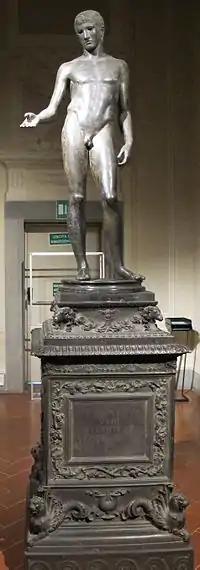
The Idolino, or Idolino of Pesaro, is a Roman bronze statue of a nude youth in contrapposto, standing 146 cm high, made in approximately 30 B.C.[1] It is a copy of a Greek sculpture in the style of Polyclitus made in approximately 440 B.C.[2] It received the name "Idolino," which is Italian for "Little Idol," in the 19th century.[3]
The statue represents a youth with his right hand outstretched. Originally thought to be a statue of Bacchus, it is now believed to have been used to hold an oil lamp at dinner parties.[4] It was influenced by the Doryphoros of Polyclitus.
The statue is on a bronze and silver base, 152 cm high, made in 1530-40 by Aurelio, Ludovico, and Girolamo Lombardo. Because of the mistaken belief that the statue was of Bacchus, the base is decorated in honor of that god.[5] The front of the base bears an inscription by Pietro Bembo; the sides bear scenes of the triumph of Ariadne and of the sacrifice of a goat in a Bacchic rite. The pedestal is assembled from four large sections of hollow, four-sided moldings; its ornamental vocabulary suggests an altar.[6]
The statue was unearthed in 1530 in a Roman villa in Pesaro and came into the possession of Francesco Maria I della Rovere, the Duke of Urbino. The statue was preserved almost intact; only the right hand had to be restored. The fragmented bronze vine that was found with the statue and originally held in the right hand was no longer attached; that vine led to the misidentification as Bacchus. In 1630, the statue was bequeathed by the Medici and transferred to Florence as a gift celebrating the wedding of Vittoria della Rovere and Ferdinand II, Grand Duke of Tuscany. After interim installations in the Uffizi and a "guest stay" in Palermo 1800–1803, when it was necessary to avoid the risk of requisition by Napoleon and to keep the statue in a safe place, the statue was permanently located in 1897 in the Archaeological Museum of Florence.[7]
References
- ↑ "Figure of a youth, so-called 'Idolino of Pesaro,'" from the Databases of Ancient Art
- ↑ "Idolino," from Encyclopædia Britannica
- ↑ The "Idolino", from National Gallery of Art
- ↑ Idolino, from Museum of Classical Archaeology, Cambridge
- ↑ Exhibition Checklist: Power and Pathos: Bronze Sculpture of the Hellenistic World, from the Getty Museum
- ↑ ‘…con uno inbasamento et ornamento alto’: the rhetoric of the pedestal c. 1430-1550, Alison Wright, University College London
- ↑ "Der „Idolino" – Der Bronzejüngling in Florenz, from Skulpturhalle Basel". Archived from the original on 2015-07-02. Retrieved 2016-02-09.